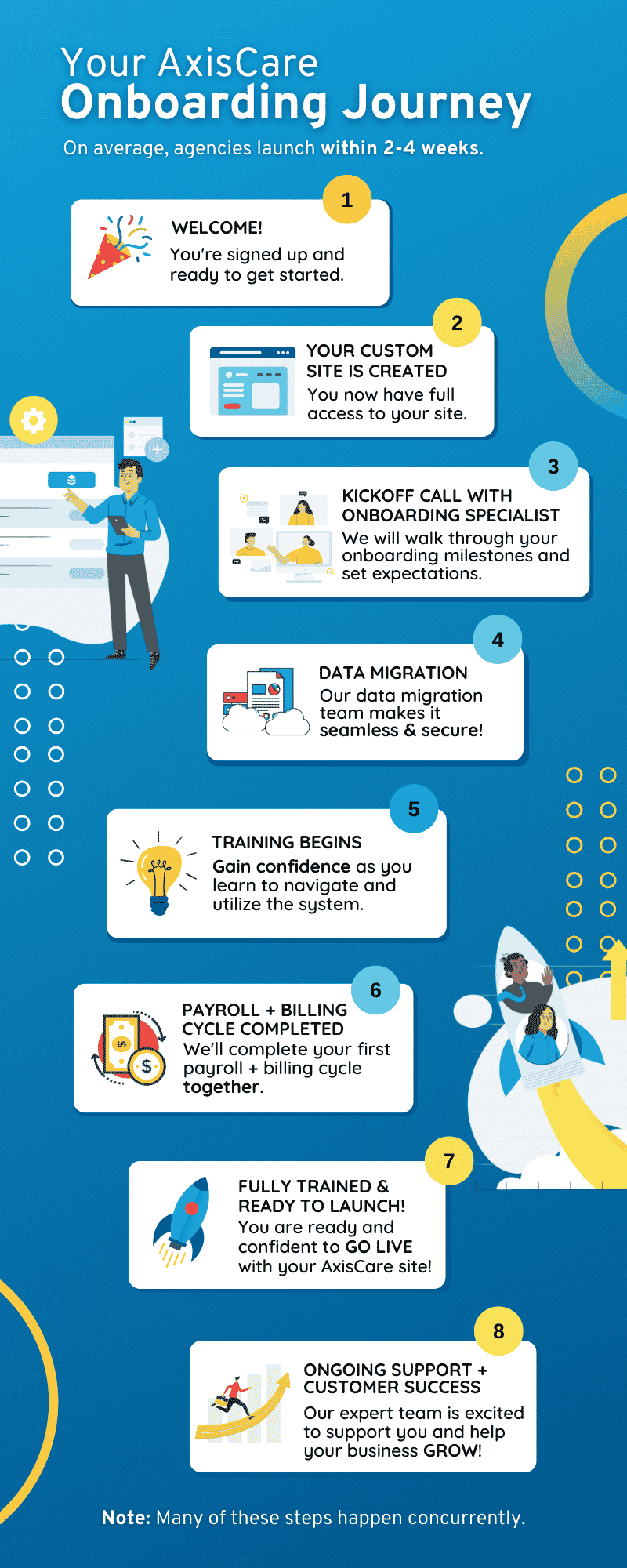Scheduling remote caregivers requires so much more than throwing appointments on a calendar. It’s a complex task that includes matching clinicians to each patient’s needs, creating efficient routes, reducing the risk of missed appointments, and keeping costs at bay.
When done correctly, home health scheduling creates a friction-free process that boosts satisfaction among caregivers and patients, while reducing burnout for practitioners who are on the move.
Understanding Home Health Scheduling & Routing
In a clinic or hospital setting, when patients make an appointment, they come to you. But home health scheduling requires agencies and providers to put the pieces of the puzzle together.
It’s a process that’s rife with opportunities for human error: booking appointments, optimizing caregiver routes, avoiding scheduling conflicts, and allocating the necessary paperwork. Home care scheduling software can automate all of these processes and more.
Scheduling in-home healthcare involves the creation of a structured plan that outlines when and where healthcare providers will visit patients. Routing determines the most efficient path for healthcare providers to follow as they move from one patient’s location to another.
These two variables must be carefully coordinated to deliver the best possible care for patients while eliminating friction for caregivers.
Caregivers shouldn’t be traveling across the city multiple times per day; that’s a waste of time, money, and energy. Using home care software to reduce the distance between appointments and improve operational efficiency enables them to support more patients, reduce costs, and feel less burnt out at the end of their shift.
Factors Affecting Scheduling & Routing
There are many factors that influence an agency’s scheduling and routing decisions – that’s what makes it such a complicated task.
No two patients’ needs are the same, so agencies need to be strategic with their resource allocation. Scheduling and routing must consider the specific care requirements of each patient, and which team members can meet those requirements.
Caregiver Availability & Skills
When scheduling and routing caregivers, it is important to consider their individual strengths and skill sets to ensure that they are paired with the right patients. Caregivers’ preferences and abilities – like allergies and prior training, for example – should also be taken into account.
Patients and caregivers are both running on their own schedules; home health care scheduling software must take into account their respective time windows to ensure that care is provided efficiently and effectively.
Grouping patients who are in close proximity to each other can reduce caregivers’ commute times, enabling them to treat more patients and reducing the cost of travel. Reducing the distance between visits also helps account for factors like traffic.
There are plenty of ways to address the most common challenges related to caregiver scheduling and routing. Here are a few tips to consider:
- Homecare scheduling software can automatically detect which patients are located near each other. It then groups bookings together based on location to reduce travel time and increase efficiency.
- Navigation tools have become ubiquitous on the road, and in-home care scheduling software has GPS built right into its interface. This makes it easy for clinicians to optimize routes on the fly and reduce travel time.
- Providers can optimize scheduling and routing by planning ahead for potential disruptions, such as traffic or weather delays, and adjusting schedules accordingly.
- Even with proper planning, unexpected challenges can still arise. Scheduling and routing should be flexible enough to adapt to changes in real-time, such as last-minute cancellations or changes in patient needs.
Technological Solutions
Taking all of these factors into account might seem daunting, but in-home care scheduling software is built for exactly these purposes! Instead of crunching these calculations manually, let a specialized platform manage your appointments with ease.
Automated scheduling systems take care of everything. Purpose-built algorithms identify the best caregiver for each shift based on their skills and availability, automatically calculate and optimize driving distances, intelligently fill vacant shifts, and so much more.
Remote clinicians need solutions that suit their on-the-go workflow. Mobile apps can be used to optimize scheduling and routing by providing no-show updates, shift reminders, location tracking, and other features that can improve efficiency and communication between caregivers and patients.
Electronic Visit Verification (EVV) is an efficient way to streamline caregiver activity and remain compliant with industry standards. From clocking in and out to inputting essential appointment details, your team can manage their time and schedule while on the go. On the agency side, EVV provides countless advantages, including greater insight into employees’ workdays and therefore an increased ability to improve their processes over time.
Benefits of Optimizing Scheduling & Routing
Home care agencies have so much to gain from approaching their scheduling and routing strategically – not just for caregivers, but for patients too.
Optimizing scheduling and routing provides many benefits, including:
- Reduced Wait Times: By reducing the distance between appointment locations, agencies are also reducing the risk of running into traffic or other issues. That means remote practitioners are more likely to show up on time instead of keeping patients waiting.
- Enhanced Caregiver Productivity: The easier it is to get from visit to visit, the more caregivers can accomplish in a given day. Home health agencies’ services are in high demand, so it’s imperative to maximize employee “uptime” instead of wasting precious time on the road.
- Cost Savings: Inefficiency isn’t just bad for employee and patient satisfaction – it’s also expensive! Paying for extra gasoline or caregiver overtime is commonplace when scheduling and routing haven’t been optimized. But with careful planning and consideration, these extra costs can be significantly reduced.
- Increased Caregiver & Patient Satisfaction: Everyone’s happier when appointments are running on time. Agencies increase trust between themselves and their patients, caregivers spend less time stuck in their vehicles, and everyone is able to avoid unnecessary disruptions to their daily schedules.
- Better Communication: Thanks to features like real-time updates and patient information tracking, the same software applications that handle agencies’ scheduling and routing also keep stakeholders connected throughout the day. Information is uploaded to a single hub, which everyone can access and update live.
Adopt Technology-Driven Strategies With AxisCare
Why use guesswork to optimize your scheduling and routing? AxisCare uses intelligent algorithms to do the heavy lifting for you, drastically reducing administrative burden, human error, and inefficiency.
To learn more about how we help agencies improve care on all levels, book a demo today.









